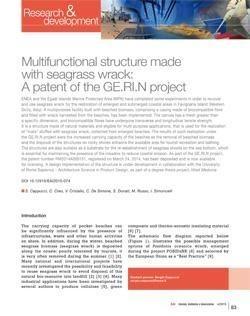ENEA and the Egadi Islands Marine Protected Area (MPA) have completed some experiments in order to recover and use seagrass wrack for the restoration of emerged and submerged coastal areas in Favignana Island (Western Sicily, Italy). A multipurpose facility built with beached biomass, comprising a casing made of biocompatible fibre and filled with wrack harvested from the beaches, has been implemented. The canvas has a mesh greater than a specific dimension, and biocompatible fibres have undergone transverse and longitudinal tensile strength. It is a structure made of natural materials and eligible for multi-purpose applications, that is used for the realization of “mats” stuffed with seagrass wrack, collected from emerged beaches. The results of such realisation under the GE.RI.N project were the increased carrying capacity of the beaches as the removal of beached biomass and the disposal of the structures on rocky shores enhance the available area for tourist recreation and bathing. The structures are also suitable as a substrate for the re-establishment of seagrass shoots on the sea bottom, which is essential for maintaining the presence of the meadow to reduce coastal erosion. As part of the GE.RI.N project, the patent number RM2014A000151, registered on March 24, 2014, has been deposited and is now available for licensing. A design implementation of the structure is under development in collaboration with the University of Rome “Sapienza” – Architecture Science in Product Design, as part of a degree thesis project, titled Medonia
Struttura multifunzionale realizzata con alghe marine spiaggiate: un brevetto del progetto GE.RI.N
Il Dipartimento Sostenibilità dei Sistemi Produttivi e Territoriali dell’ENEA e l’Area Marina Protetta (AMP) delle Isole Egadi, hanno completato alcuni esperimenti per recuperare ed utilizzare le biomasse vegetali spiaggiate per il ripristino di aree costiere emerse e sommerse nell’Isola di Favignana (Sicilia Occidentale, Italia). Una struttura multifunzionale è stata costruita con biomassa vegetale: questa comprende un involucro realizzato con fibra biocompatibile, riempita di biomassa raccolta dalle spiagge; le dimensioni della maglia e la resistenza alla trazione longitudinale e trasversale sono ben definite. Si tratta di una struttura fatta di materiali naturali che possono trovare molteplici applicazioni, quali la realizzazione di "tappetini" ripieni di posidonia assemblabili tra loro in vario modo. I risultati degli interventi sperimentali condotti nel progetto GE.RI.N sono stati: la maggiore capacità di carico delle spiagge dovuta alla rimozione della biomassa spiaggiata e alla distribuzione delle strutture sulle coste rocciose, al fine di aumentare la superficie disponibile per la ricettività turistica e balneare. Le strutture sono, inoltre, adatte come substrato per la riqualificazione del fondo del mare, che è essenziale per mantenere o reimpiantare la prateria madre e per ridurre l'erosione costiera. Nell’ambito del progetto GE.RI.N, è stato depositato il brevetto n. RM2014A000151, in data 24 marzo 2014, ed è ora disponibile per le licenze. In collaborazione con l'Università degli Studi di Roma “Sapienza” – Facoltà di Architettura e Scienze del Design del prodotto - è ora in corso una implementazione della progettazione delle strutture, come parte di un progetto di tesi di laurea intitolato “Medonia”


